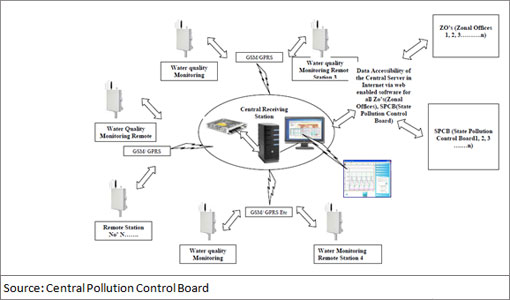CPCB's Real time water quality monitoring
In order to eliminate problems associated with manual water quality monitoring, Central Pollution Control Board (CPCB) has planned to go for hi-tech solution. CPCB is planning to install ‘Real Time Water Quality Monitoring Network’ across Ganga Basin for testing ten parameters. The Ganga is the largest and the most important river of India, with its watershed covering 10 Indian states, namely Uttaranchal, Uttar Pradesh, Bihar, Jharkhand, West Bengal, Himachal Pradesh, Rajasthan, Haryana, Madhya Pradesh and Delhi. Discharge of untreated sewage from urban centres is a major cause of water quality degradation in the river. The total wastewater generation from 222 towns in Ganga basin is reportedly 8250 MLD, out of which 2538 MLD is directly discharged into the River, 4491 MLD is disposed into its tributaries and 1220 MLD is disposed on land or low lying areas. “River Yamuna is one of the most grossly polluted rivers in the country. There are number of inter-state issues and events of episodal pollution. In case of Ganga, we have to address large number of petitions, RTIs, VIP references etc and the NGRBA is constituted for large scale investment towards STPs etc”, says Dr R M Bhardwaj, Senior Scientist, Central Pollution Control Board
The parameters that CPCB plans to monitor online are pH, turbidity, conductivity, temperature, Dissolved Oxygen, Dissolved Ammonia, Bio-chemical Oxygen Demand, Chemical Oxygen Demand, nitrates and chlorides. All the stations will be operational in real time mode and central station will be able to access data from any of these stations. The stations will also be tolerant to extreme environmental conditions in India such as high or low temperature, high humidity coastal conditions and high temperature desert conditions. Moreover, the stations will be such that it won’t require manual intervention for at-least 5 years, except for routine calibration and battery replacement.
| How it works? The real time water quality instrument has different in-built instruments to measure different parameters. Spectrometer probe can measure SS, COD, BOD, TOC, Nitrate, Colour and Turbidity. Spectrometer probe operates using the principle of UV Spectrometry. It can measure optical spectra from 200 to 750 nm directly in liquid media. The substances contained in the medium weaken a light beam emitted by a lamp that moves through the liquid. After contact with the medium its intensity is measured by a detector over a range of wavelengths specific to the application. Optical sensors operate using the principle of optical or fluorescence can monitor dissolved oxygen & temperature. pH, Conductivity, Salinity and Temperature can be measured/monitored using the principal of multi parameter electrode . Amperometric membrane can monitor free chlorine (Cl2 + HOCl + OCl-) or total chlorine (free chlorine + combined chlorine). |
All the water quality monitoring stations will be fitted with GSM, GPRS for communication with the central receiving station. The central receiving station will have software for data acquistion, data analysis, data display and report generation. Zonal offices of CPCB and State Pollution Control Boards will have direct access to the data from central receiving station. “This is a pilot study. There are success stories in the western world. Technology is available and being used overseas. There are success stories with Continuous Air Quality Monitoring and we hope to achieve success in real time water quality monitoring also. There is major shift in the communication system for transmission of data and the same will be utilised for remote vigilance in the case of water quality also” says Dr Bhardwaj.
Figure 1: How system works?

“Earlier, with manual sampling we used to get analysis report of one sample in a month. But with real time monitoring, we will get at least 50 and a maximum of 95 data every day. Regular and large number of data will enable us to take decision which can be implemented on time and is effective”, adds Dr Bhardwaj.
Cost the limiting factor
Despite, good features and reliability cost of instruments for testing water quality may become a hindrance for Boards. Costs of instruments are dependent on parameters to be measured. In case, one needs instruments to monitor all the ten parameters, then the instrument will cost Rs 35-40 lakhs and operation and maintenance will be carried out by the supplier. Since, the data quality and data availability is an issue; there will always be a temptation to upscale the project to more monitoring stations. This has a huge financial implication. Nevertheless, it is not a bad choice considering poor quality data available for policy-makers. “Funding is always an issue even for manual monitoring. Need based automation is the requirement and possibility will be explored to gather funds for specific areas/rivers” concludes Dr Bhardwaj.
|
Proposed areas for monitoring stations |
|
Source: Central Pollution Control Board |
Written by: Nivit Kumar Yadav
Email: nivit@cseindia.org
Previous Training Programmes
Press Releases
Bulletin
Story
Down to Earth

November 20, 2017

November 20, 2017
.jpg)
November 20, 2017
.jpg)
November 20, 2017
Show cause notices to 11 Nashik factories for polluting Godavari

November 20, 2017
| Studies/Publications | |
| Assistance for Abatement of Pollution | |
| National Conference on Toxic Chemicals Management | |
| Food As Toxin | |
| Contributing Authors | |
| Chandra Bhushan | |
| chandra@cseindia.org | |
| Nivit Kumar Yadav | |
| nivit@cseindia.org | |

Share this article